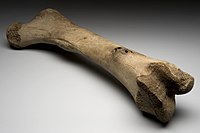
Photo from wikipedia
Background and Objectives: The extracellular matrix is important for adipose tissue growth, and numerous interactions between adipocytes and extracellular matrix components occur during adipose tissue development. The main objective of… Click to show full abstract
Background and Objectives: The extracellular matrix is important for adipose tissue growth, and numerous interactions between adipocytes and extracellular matrix components occur during adipose tissue development. The main objective of this study was to investigate the interaction and influence of maternal and postnatal diet on adipose tissue remodeling in Sprague Dawley offspring. Materials and Methods: 10 Sprague Dawley females were randomly divided into two groups at nine weeks of age and fed a standard laboratory diet or high-fat diet for six weeks. Then, they were mated, and after birth, their male rat offspring were divided into four subgroups according to diet. After euthanizing the offspring at 22 weeks of age, samples of subcutaneous, perirenal and epididymal adipose tissue were collected. Sections were stained with Mallory’s trichrome and analyzed by immunohistochemistry for CD68+ and CD163+ cells. Results: Staining of extracellular components showed higher collagen deposition in the perirenal and epididymal depot of offspring fed a high-fat diet. The number of CD163/CD68+ cells in the perirenal adipose tissue was lower in the CD-HFD group compared with other groups, and in the subcutaneous fat pad when the groups with modified diet were compared with those on non-modified diet. Conclusion: Morphological changes in adipose tissue, increased collagen deposition, and changes in macrophage polarization may be related to intergenerational changes in diet.
Journal Title: Medicina
Year Published: 2023
Link to full text (if available)
Share on Social Media: Sign Up to like & get
recommendations!